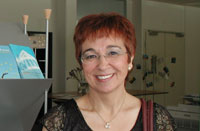Project team

Angela Hasselgreen (Coordinator)
Professor
Norwegian Study Centre, University of York
United Kingdom
|

Karmen Pižorn
Assistant Professor
Faculty of Education, Ljubljana Slovenia
Slovenia |

Violeta Kaledaité
Associate Professor-Head of English Philology Department
Vytautas Magnus University
Lithuania
|

Natàlia Maldonado
Education Department
Generalitat de Catalunya
Spain |
Project

These are the results from a project of the European Centre for Modern Languages within its "Empowering Language Professionals" programme 2008-2011.
Read more about the project
Background to the AYLLIT project
This website results from a project run within the ECML's (European Centre for Modern Languages) Empowering Language Professionals programme entitled "Assessment of young learner literacy linked to the Common European Framework of Reference for Languages".
Abstract of the project
The CEFR is increasingly drawn on as the basis for both teaching and assessing languages in schools – reflected in curricula and number of ELPs produced for young learners (see Council of Europe web and Hasselgreen 2005b).
- The CEFR was originally designed for adults and has six levels, which represent a lifelong span. Only the lower levels (up to B1) appear to cater for the cognitive maturity of younger pupils, and these levels need to be adapted to the actual language-use situations of these learners. To reflect progress, in-between stages need to be defined.
- The ECML's Bergen can-do project (2000-2003) contributed to adapting the CEFR to lower secondary school pupils, through surveys of what learners and their teachers believed they could do. A further study is needed to identify features of learners as they progress through upper primary school. In order to ensure that actual progress is captured, longitudinal studies should be used. This is being embarked upon with schools in Bergen in autumn 2007.
- There is an increasing demand in the curricula of European countries that teaching is adapted to the individual learner. In order to be able to do this, it is necessary that teachers are able to identify which level their learners are 'at' at any time.
- Teachers of languages in primary schools in Europe are generally not language specialists and few have education in assessment (see Hasselgreen. 2005 and Ealta survey Hasselgreen, et al, EALTA website).
- This project attempts to provide teachers of young language learners (9-13 years) with the necessary tools for assessing pupils’ reading and writing, using criteria linked to the 'portion' of the CEFR relevant to this age group. The minimum age of 9 years is set so that L1 literacy can generally be assumed.
The project will have the opportunity to study the language of young learners, who may be at different institutional stages of schooling, and have varying lengths of study time in the target languages.
Acknowledgement
The Ayllit publication and website result from the work of an international network established within one of the ECML projects. We would like to thank all who worked on Ayllit, in particular the project coordination team for their motivation and active involvement.